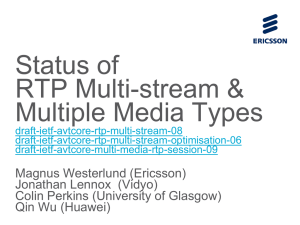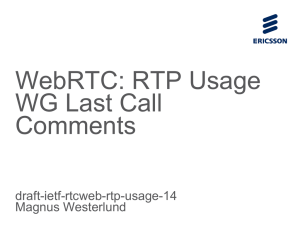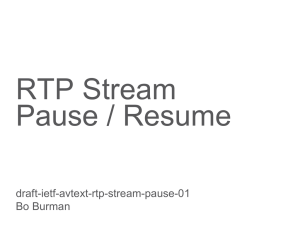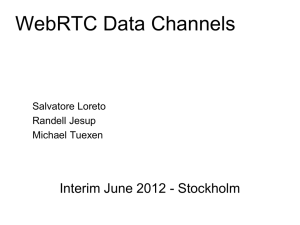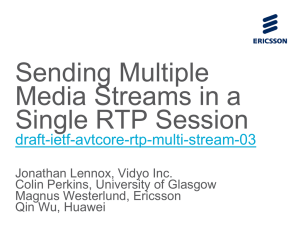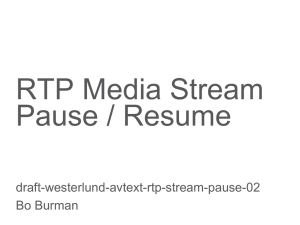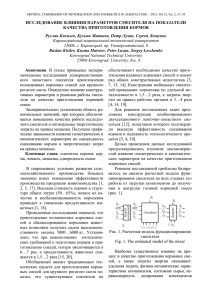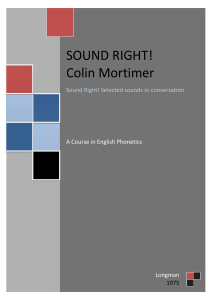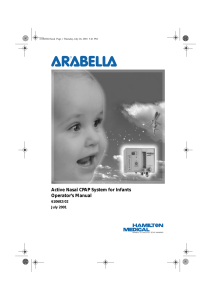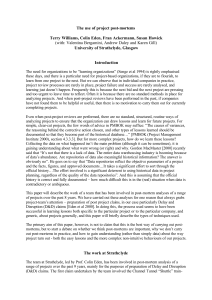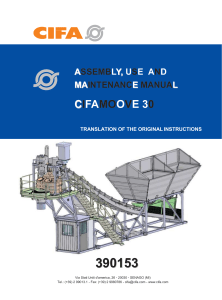RTP for WebRTC: Part 1 Topologies
реклама
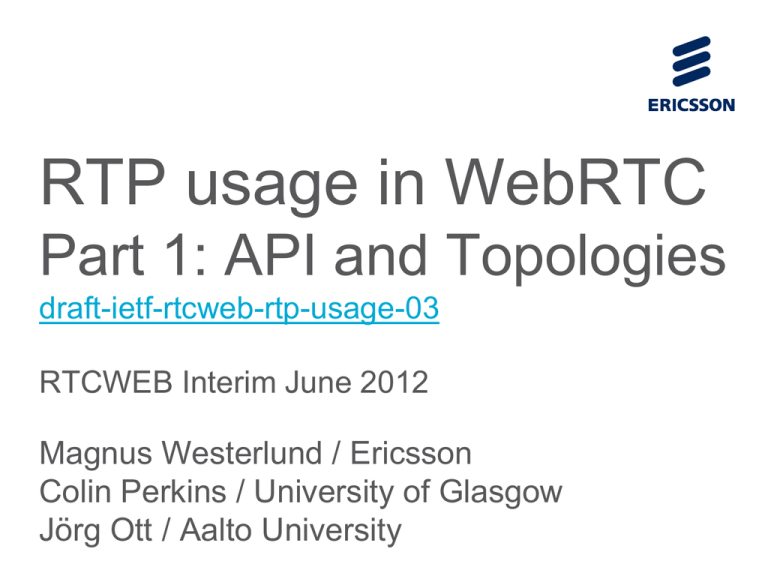
RTP usage in WebRTC Part 1: API and Topologies draft-ietf-rtcweb-rtp-usage-03 RTCWEB Interim June 2012 Magnus Westerlund / Ericsson Colin Perkins / University of Glasgow Jörg Ott / Aalto University Introduction › WebRTC’s usage of RTP, Extension and related topics will be split into two presentations: 1. WebRTC API and RTP Topologies (Magnus) 2. RTP/RTCP usage, Extensions etc. Implementation requirements (Colin) RTP Usage in WebRTC | RTCWEB WG Interim June 2012 | Magnus Westerlund & Colin Perkins | 2012-06-05 | Page 2 Goals › The goals with these presentations are: – Increase your awareness of the content of the RTP specification – Highlight the Open Issues that need your input – Enable discussion of the document › Find additional Open Issues › Find disputed requirements RTP Usage in WebRTC | RTCWEB WG Interim June 2012 | Magnus Westerlund & Colin Perkins | 2012-06-05 | Page 3 Outline › Part 1 – Goals – Definitions – WebRTC API – Topologies affects end-point functionality – Simulcast › Part 2 – Core RTP functionality – RTP/RTCP Extensions – Transport Robustness – Rate Control – Performance Monitoring RTP Usage in WebRTC | RTCWEB WG Interim June 2012 | Magnus Westerlund & Colin Perkins | 2012-06-05 | Page 4 Definitions › RTP Session – One SSRC space (32-bits); commonly identified by one or more address+port (destinations) › SSRC – Sender Source (a 32-bit number), – a RTP stream source identifier, – independent Sequence number and Timestamp space › Media Stream: A sequence of media fragments that together form a realtime experience of the media, – like a video sequence or an audio stream from a media source › RTP (Media) Stream – A sequence of RTP packets with the same SSRC – providing the receiver with a encoded media stream from a media source › Media Source – The source of a particular media type – Microphone – Video camera – Conceptual media source › Created from a set of other media sources, like a media mix, a selection between video cameras, etc. RTP Usage in WebRTC | RTCWEB WG Interim June 2012 | Magnus Westerlund & Colin Perkins | 2012-06-05 | Page 5 WebRTC API RTP Session B RTP Session RTP Session RTP Usage in WebRTC | RTCWEB WG Interim June 2012 | Magnus Westerlund & Colin Perkins | 2012-06-05 | Page 6 SSRC3 RTP Session – A Media Stream that over RTP will Peer Connection be represented by a SSRC TRACK › MediaStreamTrack SSRC2 – A set of MediaStreamTracks – Synchronized playback MS3 SSRC1 › MediaStream – An WebRTC API MediaStream TRACK MS2 TRACK TRACK MS1 TRACK A TRACK – Containing one or more RTP sessions – Sent using one or more bidirectional UDP flow. TRACK › PeerConnection – An Association between two peers WebRTC API › Things to Note: – MediaStream › More than one MediaStream may include the same Media Source › Multiple MediaStream:Tracks maps to the same Source and SSRC › MediaStream and tracks are unidirectional › Only proposal for how to establish MediaStream and Track mapping to RTP SSRC are in draft-alvestrand-rtcweb-msid-02 – To provide synchronization in RTP all Tracks in a MS must be sent using a common CNAME › MediaStreamTracks may be from multiple different sources / end-points - Different synchronization contexts - A combing WebRTC node must then provide a common synchronization context – A PeerConnection can contain › multiple UDP Flows › RTP sessions › Still only one PeerConnection RTP Usage in WebRTC | RTCWEB WG Interim June 2012 | Magnus Westerlund & Colin Perkins | 2012-06-05 | Page 7 Topologies › Topologies – Point-to-Point – Multi-unicast (MESH) – Mixers – Relay – End-point Forwarding – Simulcast › Functionality groups › Conclusions RTP Usage in WebRTC | RTCWEB WG Interim June 2012 | Magnus Westerlund & Colin Perkins | 2012-06-05 | Page 8 Topologies › The topologies created for a multi-media session affects end-point functionality › This part of the presentation will: – Investigate a set of possible topologies in WebRTC – Discuss their main merits – Consider what functionality from an end-point they require › How topologies relate to groups of functionality will be summarized › Discuss recommendation on Topologies support RTP Usage in WebRTC | RTCWEB WG Interim June 2012 | Magnus Westerlund & Colin Perkins | 2012-06-05 | Page 9 Point to Point › The Point to Point is the basic topology › A WebRTC end-point needs to support: – Multiple Sources (SSRCs) in one RTP session – One or More RTP sessions › Over one or more UDP flow (5-tuple) – Congestion Control – Codec Control of individual sources – Transport Robustifications – Common Security Functions › SRTP › DTLS-SRTP key management – Setup Signalling RTP Usage in WebRTC | RTCWEB WG Interim June 2012 | Magnus Westerlund & Colin Perkins | 2012-06-05 | Page 10 A B A Multi-Unicast (MESH) › A End-point establish multiple PC – Each PC has its own RTP session(s) – Common or Independent Media Encoders – Individual control and quality for each PC B C › No Central Node – No need for media related infrastructure beyond NAT traversal – Increased bandwidth consumption in common path from end-point › Controlling which media streams, bit-rate and quality – Distributed task as the independent PC affect each other › An end-point must be capable of combing media from multiple PC for concurrent playout and audio mixing RTP Usage in WebRTC | RTCWEB WG Interim June 2012 | Magnus Westerlund & Colin Perkins | 2012-06-05 | Page 11 Mixers MIXER › There are several types of mixers – Media Mixers – Stream Switching – Source Projecting A B C D › The have the following common properties – End-point communicates only with Mixer using a PC › The Mixer provides the other participants over that PC – Must be trusted devices and have media keys › Changes media or RTP headers – Tries to optimize the conference for each participant RTP Usage in WebRTC | RTCWEB WG Interim June 2012 | Magnus Westerlund & Colin Perkins | 2012-06-05 | Page 12 Media Mixer MIXER A › A Media Mixer will commonly: ENC DEC B MIX – Decode incoming media streams DEC DEC C – Mix or composite the selected media – Re-encode and transmit to the target › Encoding can be tailored to receivers capability and path D › Mixers will use their own SSRC when sending the encoded stream – Use CSRC field to provide receiver with contributing sources in mix – Only Source Descriptions (SDES) and BYE RTCP packets are forward between legs in RTCP – Mixer will have to control upstream media source based on what is most suitable for all receivers of the content in the conference RTP Usage in WebRTC | RTCWEB WG Interim June 2012 | Magnus Westerlund & Colin Perkins | 2012-06-05 | Page 13 Stream Switching MIXER A RTP Rewrite B › Mixer uses conceptual SSRCs, e.g. – Video of the most important speaker – 4 SSRCs for Thumbnails of the last 4 speaker not included in most important speaker C D › The Mixer constantly evaluates and selects which stream is selected to be forwarded by the Mixer’s SSRC – RTP headers must be rewritten to ensure consistent streams – CSRC field can be used to indicate identity of source › To enable switching between video streams – Full Intra Request are crucial › Mixer must monitor congestion on the legs to the different receivers – Simulcast or scalability enables multiple quality tiers – To adjust a quality tier to better suite the set of receivers codec control and bitrate adjustments are needed › Receivers of the same stream will get the same content and quality RTP Usage in WebRTC | RTCWEB WG Interim June 2012 | Magnus Westerlund & Colin Perkins | 2012-06-05 | Page 14 Source Projection MIXER A RTP Rewrite › Each participant and the mixer have their own RTP Session › The sources in the other sessions C are projected by the mixer into the other sessions › There is a one to one mapping between SSRCs in the local session and the original media sources › Mixer optimizes by selecting which sources are currently forwarded to this session – RTP headers must be rewritten to ensure consistent streams to receiver – Mixer needs to be able to both initiate and forward control requests between RTP sessions. › All Receiver of particular stream gets the same content and quality RTP Usage in WebRTC | RTCWEB WG Interim June 2012 | Magnus Westerlund & Colin Perkins | 2012-06-05 | Page 15 B D Relay (Transport Translator) Relay › A Relay is a media node that – Only rewrites transport headers (IP/UDP) – Functions without Crypto keys to media – Create a common RTP session between all participants A B C D › End-point is required to handle multiple end-points in session – Merge feedback results into common adaptation decision – All receivers get the same content – Keying of session needs more than DTLS-SRTP, e.g. EKT – For cryptographic source authentication of individual sources extensions like TESLA are required RTP Usage in WebRTC | RTCWEB WG Interim June 2012 | Magnus Westerlund & Colin Perkins | 2012-06-05 | Page 16 End-Point Forwarding › A delivers MediaStream to B A – B decides to forward it to C › Simple on API level › More complicated in Implementations – Forward the media stream received into other PC › Relay functionality › Maintain quality from source › Source Authentication of A possible › A must adapt media to all receivers – Transcode or rewrite stream before sending it to C › Mixer based functionality › Each transcoding reduces quality › B needs mixer logic and adaptation support › Trust on B to not modified A’s content RTP Usage in WebRTC | RTCWEB WG Interim June 2012 | Magnus Westerlund & Colin Perkins | 2012-06-05 | Page 17 B RTP Sink C Simulcast › Simulcast, i.e. to provide multiple encodings of the same media source to the Peer › The different encoding are used to A B ENC ENC – Provide different end-points with different codecs – Provide different quality tiers to be used in Stream Switching or Source Projection Mixers › A way of achieving Simulcast are: – Establish two PeerConnections with different encoding parameters for the same MediaStreamTrack – Multiple MSTracks from one media source in the same PeerConnection › A end-point could optimize local resources as discussed in Multiunicast – Need to be able to ensure different encodings are provided if at all possible RTP Usage in WebRTC | RTCWEB WG Interim June 2012 | Magnus Westerlund & Colin Perkins | 2012-06-05 | Page 18 Source Identity in Multiparty › In the topologies that provides multiparty over a single PC: – Mixers – Relay – End-point Forwarding › A receiver should be able to know and cross conference identities for media sources – Relay based solutions maintain SSRC space as common identity space that can be mapped to MediaStreamsTracks – Media Mixer and Stream Switching produce conceptual media streams with contributing sources › What level of identities of contributing sources are desired? – Source Projecting Mixer can maintain common identities › Must deal with SSRC collisions across the conference › Can map local SSRCs to common MediaStreamTrack identities RTP Usage in WebRTC | RTCWEB WG Interim June 2012 | Magnus Westerlund & Colin Perkins | 2012-06-05 | Page 19 Functionality Groups › Can benefit from CSRC: – Media Mixer – Stream Switching Mixer – End-point forwarding (Mixer based) › Conference Extensions – Mixers – Relay – End-point Forwarding (both types) › Multiple End-point handling: – Relay – End-point forwarding (Relay based) › Multiple Simultaneous PeerConnections – Multi-Unicast (Mesh) – Simulcast? RTP Usage in WebRTC | RTCWEB WG Interim June 2012 | Magnus Westerlund & Colin Perkins | 2012-06-05 | Page 20 Conclusions › Need for Conference Extensions very well motivated – Question is what, see Presentation Part 2 › How to deal with Identity of contributing sources open Issue – CSRC handling is part of RTP core specification – Question more if JS application shall be provided with information › Multiple End-point handling depends on the Use Cases – Core RTP has support for this › Some implementations may be lagging – Implementations complexities in adaptation and codec control logic › Multiple Simultaneous PeerConnections – Have well established use cases – MUST be supported RTP Usage in WebRTC | RTCWEB WG Interim June 2012 | Magnus Westerlund & Colin Perkins | 2012-06-05 | Page 21
